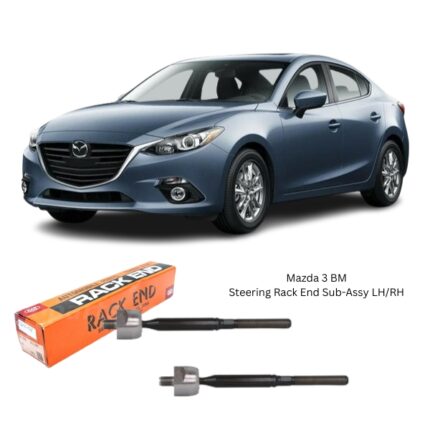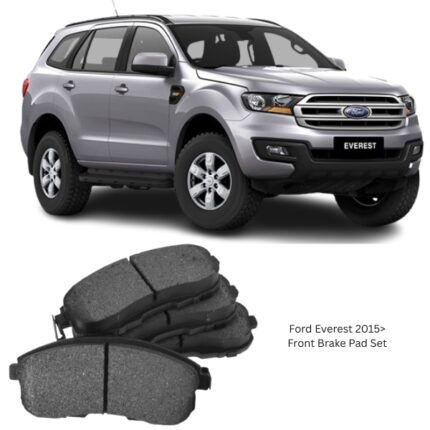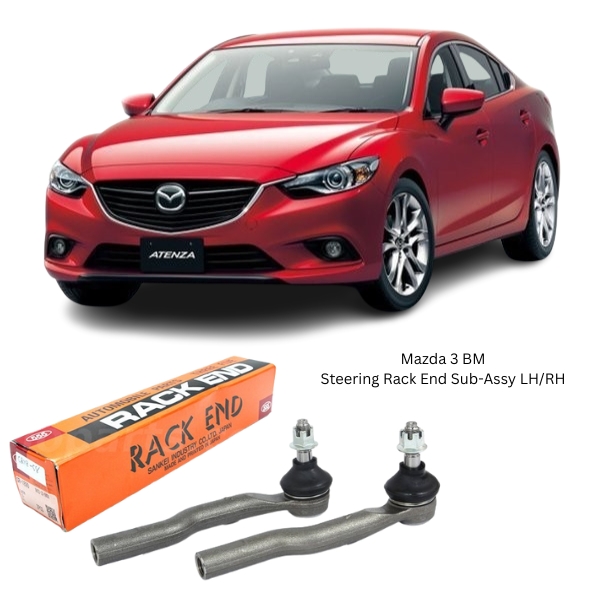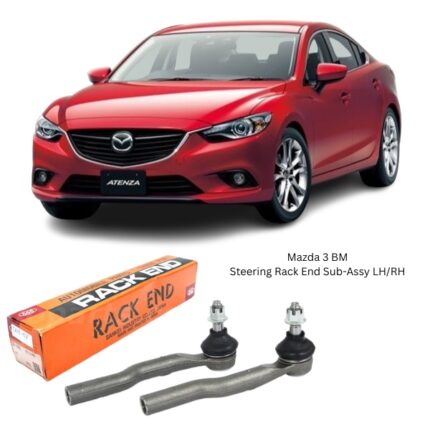Get Mazda Atenza GJ Tie Rod End Sub-Assy RH/LH SE1891 in Kenya
The Tie Rod End Sub-Assembly (RH/LH) is a vital component of a vehicle’s steering and suspension system, responsible for connecting the steering rack (or center link in some designs) to the steering knuckle, enabling the front wheels to pivot accurately in response to driver input. The “RH” (Right Hand) and “LH” (Left Hand) designations refer to the side of the vehicle on which each component is installed.
Serving as the outermost part of the steering linkage, the tie rod end allows the wheels to move laterally while maintaining vertical suspension movement. This small yet powerful assembly plays a major role in handling, stability, tire wear, and vehicle safety.
Function in the Steering System
The tie rod end sub-assembly works in tandem with the inner tie rod (rack end) to complete the steering linkage system. When the driver turns the steering wheel:
-
The steering rack moves laterally (left or right),
-
This motion is transmitted through the rack end (inner tie rod),
-
The tie rod end (outer) then pushes or pulls the steering knuckle, rotating the wheel accordingly.
In addition to transmitting steering motion, the tie rod end accommodates the up-and-down movement of the suspension, ensuring smooth articulation even on uneven terrain.
Construction and Components
A high-quality Tie Rod End Sub-Assembly includes:
-
Ball-and-socket joint: This allows the tie rod to pivot as the suspension moves. It consists of a precision-ground steel ball stud housed in a forged metal socket.
-
Threaded shaft: One end of the tie rod is threaded to allow adjustment during alignment. It connects to the inner tie rod or the steering knuckle, depending on the layout.
-
Dust boot: A rubber or polyurethane cover protects the ball joint from dirt, moisture, and debris. Keeping this boot intact is essential for long-term performance.
-
Castle nut and cotter pin (or lock nut): These secure the tie rod end to the steering knuckle and prevent movement over time.
Materials and Durability
Tie rod ends are made with hardened steel alloys to withstand the high mechanical stress experienced during steering and suspension operation. Key material features include:
-
Forged carbon or alloy steel for structural integrity,
-
Heat-treated ball studs for wear resistance,
-
Zinc or phosphate coating for corrosion resistance,
-
Polyurethane or thermoplastic elastomer boots for extended life.
Premium tie rod ends often include pre-greased sealed joints, while serviceable variants come with grease fittings (zerk fittings) for periodic lubrication.
Types of Tie Rod Ends
Depending on the steering system layout, tie rod ends can vary in design. The most common types are:
-
Outer tie rod ends: Connect the steering knuckle to the inner tie rod (rack end),
-
Inner tie rod ends (often referred to as rack ends): Connect directly to the steering rack or center link.
Some designs integrate the tie rod as a one-piece unit, while others allow for modular replacement. The RH (right-hand) and LH (left-hand) versions are often mirror images of each other and must be matched to the correct vehicle side for proper function and alignment.
Signs of Worn or Failing Tie Rod Ends
Since tie rod ends are constantly subjected to movement, vibration, and environmental exposure, they are prone to wear over time. Signs of failure include:
-
Excessive steering wheel play,
-
Clunking or knocking noises when turning or driving over bumps,
-
Uneven or accelerated front tire wear,
-
Steering wheel vibration, especially at high speeds,
-
Vehicle pulling to one side,
-
Loose or wandering steering feel,
-
Visible grease leakage or torn dust boots.
Ignoring a faulty tie rod end can lead to poor vehicle handling, alignment issues, and even complete loss of steering control, posing serious safety risks.
Installation and Replacement Guidelines
Replacing a tie rod end is a relatively straightforward procedure that requires basic mechanical skills and proper alignment afterward.
Steps for Replacement:
-
Lift the vehicle and safely support it on jack stands.
-
Remove the front wheel to access the tie rod end.
-
Loosen and remove the castle nut or locking nut at the steering knuckle.
-
Use a tie rod puller or hammer to release the tie rod end from the knuckle.
-
Mark the threads or count the turns to maintain alignment reference.
-
Unthread the old tie rod end from the inner tie rod.
-
Install the new tie rod end, matching the number of turns or alignment marks.
-
Tighten the castle nut, insert the cotter pin (if applicable), and secure all connections.
-
Reinstall the wheel and lower the vehicle.
-
Perform a professional wheel alignment immediately after installation to avoid tire wear or handling issues.
Maintenance and Longevity
Many tie rod ends today are sealed for life, eliminating the need for regular greasing. However, for serviceable types:
-
Grease the joint at regular service intervals,
-
Inspect boots for tears, cracks, or leaks,
-
Check alignment at least once a year or after hitting potholes or curbs.
Under normal driving conditions, a quality tie rod end can last anywhere from 80,000 km to 150,000 km, depending on vehicle weight, road conditions, and driving habits.
Why High-Quality Tie Rod Ends Matter
Cheap or inferior-quality tie rod ends may:
-
Wear out prematurely,
-
Lead to sloppy steering response,
-
Fail under heavy loads or emergency maneuvers.
That’s why trusted brands like 555 Sankei, CTR, Lemförder, MOOG, Febi Bilstein, Delphi, ACDelco, and TRW are recommended. These manufacturers produce tie rod ends that meet or exceed OEM standards for:
-
Fitment,
-
Load-bearing capacity,
-
Ball joint articulation, and
-
Longevity.
Compatibility and Fitment
Each vehicle requires model-specific tie rod ends depending on:
-
Suspension design (MacPherson strut, double wishbone, etc.),
-
Steering system (rack-and-pinion or recirculating ball),
-
Drive configuration (FWD, RWD, AWD),
-
Wheelbase and trim level,
-
Regional steering side (Right-Hand Drive vs Left-Hand Drive).
Always verify the part number, dimensions (thread size, length, taper), and position (RH or LH) to ensure proper fitment.
Applications
Tie rod ends are used in virtually every passenger car, SUV, pickup truck, and commercial vehicle. They are especially important in:
-
Vehicles with precision steering systems,
-
Performance and off-road applications requiring robust steering control,
-
Heavily loaded utility vehicles that demand reliable articulation and alignment.
Follow us on Facebook for more parts.





Reviews
Clear filtersThere are no reviews yet.